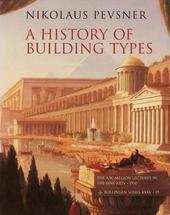
|
A History of Building Types
Paperback / softback
Main Details
| Title |
A History of Building Types
|
| Authors and Contributors |
By (author) Nikolaus Pevsner
|
| Series | Bollingen Series |
|---|
| Physical Properties |
| Format:Paperback / softback | | Pages:352 | | Dimensions(mm): Height 305,Width 229 |
|
| Category/Genre | Public buildings - civic, commercial, industrial, etc |
|---|
| ISBN/Barcode |
9780691018294
|
| Classifications | Dewey:720.9 |
|---|
| Audience | | General | | Tertiary Education (US: College) | | Professional & Vocational | |
|---|
|
Publishing Details |
| Publisher |
Princeton University Press
|
| Imprint |
Princeton University Press
|
| Publication Date |
21 December 1979 |
| Publication Country |
United States
|
Description
Available again in paperback, this first survey of building types ever written remains an essential guide to vital and often overlooked features of the architectural and social inheritance of the West. Here Nikolaus Pevsner shares his immense erudition and keenly discerning eye with readers curious about the ways in which architecture reflects the character of society. He describes twenty types of buildings ranging from the most monumental to the least, from the most ideal to the most utilitarian. More than seven hundred illustrations illuminate the text. Both Europe and America have been covered with examples chosen largely from the nineteenth century, the crucial period for diversification. Included are national monuments, libraries, theaters, hospitals, prisons, factories, hotels, and many other public buildings; churches and private dwellings have been excluded for practical reasons. The author is concerned not only with the evolution of each type in response to social and architectural change, but also with differing attitudes toward function, materials, and style.
Author Biography
Nikolaus Pevsner (1902-1983) was professor of art history at Birkbeck, University of London. His books include Pioneers of Modern Design: From William Morris to Walter Gropius and An Outline of European Architecture.
Reviews"The book is a monument of lively scholarship, and also a most revealing anthology... Gloriously informative. It brims with curious details."--Raymond Mortimer, The Sunday Times (London)
|